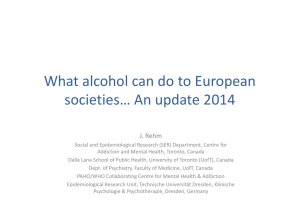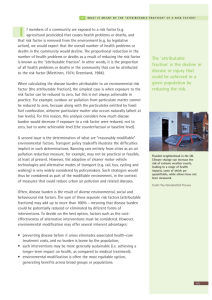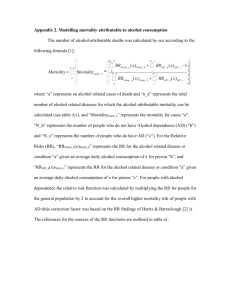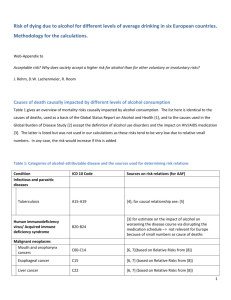Presentación de PowerPoint - Society for the Study of Addiction
advertisement
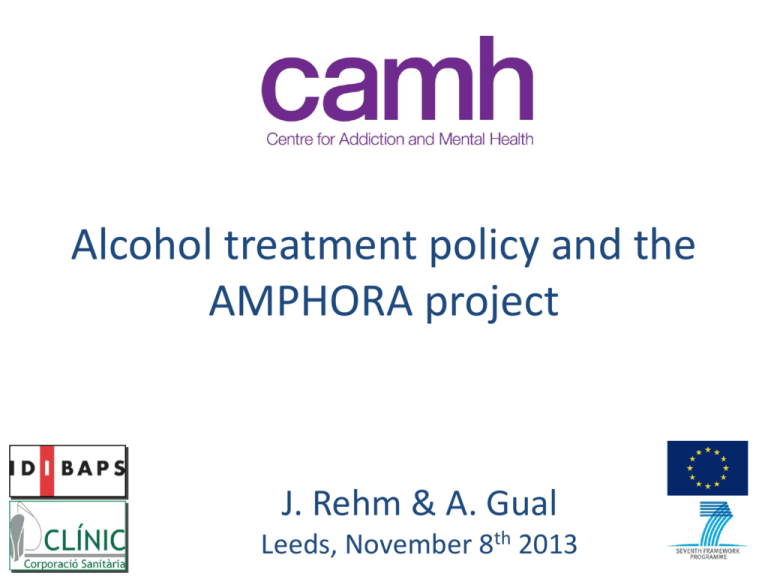
Alcohol treatment policy and the AMPHORA project J. Rehm & A. Gual Leeds, November 8th 2013 Conflicts of interest J. Rehm Interest Name of organisation Current roles and affiliations Director, Social and Epidemiological Research (SER) Department, Centre for Addiction and Mental Health, Toronto, Canada Professor and Chair, Addiction Policy, Dalla Lana School of Public Health, University of Toronto (UofT), Canada Head, PAHO/WHO Collaborating Centre for Mental Health & Addiction Head, Epidemiological Research Unit, Technische Universität Dresden, Klinische Psychologie & Psychotherapie, Dresden, Germany Grants EU FP-7, CIHR, Lundbeck, German government Honoraria Lundbeck Advisory board/consultant WHO HQ, WHO Euro, PAHO, Belgium Alcohol Plan, UK alcohol guidelines, Lundbeck, 2 Conflicts of interest T. Gual Interest Name of organisation Current roles and affiliations Addictions Unit, Psychiatry Department, Neurosciences Institute, Hospital Clinic, University of Barcelona; IDIBAPS; Vice President of INEBRIA Grants FP-7, SANCO, RETICS, Lundbeck, D&A Pharma, Honoraria Lundbeck, D&A Pharma, Servier, Lilly, Abbvie Advisory board/consultant Lundbeck, D&A Pharma, Socidrogalcohol (Alcohol Clinical Guidelines) 2013 3 Alcohol Measures for Public Health Research Alliance 2009-2012 Who are the AMPHORA partners 13 European countries 33 partner organizations More than 50 researchers Our goals: To add European knowledge to alcohol policy To disseminate this knowledge to those engaged in making policy Berzelius Symposium 84 European Debate on Evidence-based Alcohol Policy Fifth European Alcohol Policy Conference 18 – 19 October 2012 in Stockholm - Sweden www.amphoraproject.net AMPHORA project WP1 Coordination and Related Issues WP2 Epidemiology WP3 Culture and Alcohol Policy WP4 Alcohol Marketing WP5 Availability of Alcohol WP6 Early Identification and Management WP7 Drinking Environments and Harm Reduction WP8 Infrastructures for Alcohol Policy WP9 From Science to Policy E-book Second edition available on the web CHAPTER 2: WHAT ALCOHOL CAN DO TO EUROPEAN SOCIETIES Jürgen Rehm, Gerrit Gmel, Maximilien X. Rehm, Emanuele Scafato, Kevin D. Shield • We have estimated alcohol-attributable mortality and burden of disease • Using the methodology of the Comparative Risk Assessment for alcohol within the Global Burden of Disease and Injury 2005/2010 Study (GBD). • In addition, we have tried to develop guidelines for monitoring and surveillance based on efforts of the EU, the World Health Organization and the GBD study. Alcohol-attributable mortality (2004) Men Women Total % of premature deaths 13,9% 7,7% 11,9% 95% CI 8,1 – 19,2% 3,1 – 12,1% 6,5 – 16,9% Number of premature deaths 94.500 25.000 119.500 55.500 – 130.500 10.500 – 40.000 66.000 – 170.500 One in 7 One in 13 One in 8 95% CI Proportion • Premature deaths are defined as deaths in the age group between 15 and 64 years of age. The role of heavy drinking and AD Men Women Total 25 Percentage of deaths 20 15 10 5 Men Women Total 0 Alcohol-attributable 16.1% 8.5% 13.6% Alcohol-attributable (net) 13.9% 7.7% 11.8% Heavy drinking 11.1% 5.3% 9.2% Alcohol dependence 10.7% 3.7% 8.4% Alcohol-attributable deaths for people 15 to 64 years of age Heavy drinking accounts for 78 % ( 9,2% of 11,8%) of the net burden and 68 % of the total alcohol-attributable burden (9,2% of 13,6%) Rehm et al. 2012. Alcohol consumption, alcohol dependence, and attributable burden of disease Alcohol dependence incurs an enormous financial burden on society Breakdown of costs, in billions, attributable to alcohol-related problems in the EU in 2010 €12.6 €7.5 Total = €155.8 billion €21.4 €6.3 €15.1 €18.8 €45.2 €17.6 Health Treatment/prevention Mortality Absenteeism Unemployment Crime - police Crime - defensive Crime - damage Traffic accident damage €11.3 Social costs defined as costs to society, i.e., all costs arising from alcohol consumption that are not borne exclusively by the drinker, such as spending on the drinks Rehm et al, 2012 CHAPTER 9. ALCOHOL INTERVENTIONS AND TREATMENTS IN EUROPE CHAPTER 9. ALCOHOL INTERVENTIONS AND TREATMENTS IN EUROPE 1. Alcohol treatment system characteristics 2. Implementation of Screening and Brief Interventions at the practitioner level 3. The gap between need for and access to treatment for alcohol dependence. Descriptive study of alcohol intervention systems in six European countries • Key informants (government officials; senior public health specialists; senior alcohol treatment providers; senior PHC practitioners). • Formal literature search of available published and unpublished official information on provision of alcohol interventions • Semi-structured questionnaires based on previous published, mapping the provision of alcohol interventions, (PHEPA, UK National Audit Office - 2008, and WHO - 2010). Problems found • Drawing meaningful comparisons on national prevalence of AUD and numbers receiving an alcohol-specific intervention presented challenges. • Data are available across all countries on patients who have received specialist treatment, but methods of coding and recording are different. • In the case of hospital discharge diagnoses it is unclear if patients identified with alcohol dependence actually received an alcohol intervention as opposed to being in hospital only for treatment of a physical illness (e.g. alcoholic liver disease). • The resulting between-country comparisons are therefore less robust than would be ideal. • Countries were able to provide little recorded or monitored information on SBI taking place within non-specialist settings Implementation of Screening and Brief Interventions at the practitioner level • Random sample of 100 primary care staff in each country: 683 participants. • Five A&E departments in each country. 20 staff from each department were invited to complete the survey • Survey based on the UK (Kaner et al., 2008; Deluca et al., 2008), US and WHO surveys of health professionals on the identification and management of AUDs, which included the Short Alcohol and Alcohol Problems Perception Questionnaire (SAAPPQ, Anderson and Clement, 1987). Sample demographics and patients seen and screened positive for AUD per week Country Gender Age Patients Patients screen (% males) (Mean) per week positive/week (%) Austria 46.5% 55.2 285 6.54 (2.5%) Germany 53.4% 53.8 203 7.76 (3.8%) Italy 74.2% 56.2 117 5.18 (4.4%) Spain (Catalonia) 23.3% 47.3 149 4.14 (2.8%) Switzerland 61.8% 52.5 98 4.40 (4.5%) UK (England) 52.4% 46.5 110 3.87 (3.5%) Total (mean) 56.3% 52.7 154 5.34 (3.5%) Are GPs familiar with standardized alcohol screening tools? 100% 90% 80% 70% 60% 50% 40% 30% 20% 10% 0% UK Spain Italy YES Germany NO Austria Swiss Are GPs familiar with brief interventions 100% 90% 80% 70% 60% 50% NO 40% YES 30% 20% 10% 0% UK Spain Italy Germany Austria Swiss The gap between need for and access to treatment for alcohol dependence. • Need for treatment: Data was combined from country reports, to estimate the prevalence of alcohol dependence in each country. • Access to treatment: All available published or unpublished national data on patients accessing specialist treatment was identified. Data on self-help and mutual aid organisations was not included. % 0 10 20 30 40 50 60 70 80 90 100 Germany England Austria Switzerland Spain Italy Per cent of adults who would benefit from treatment for sustained heavy alcohol use who actually receive treatment Part 3: What would happen if people received more treatment? • Based on Rehm, J., Shield, K.D., Rehm, M.X., Gmel, G., & Frick. U. (2013). Modelling the impact of alcohol dependence on mortality burden and the effect of available treatment interventions in the European Union. European Neuropsychopharmacology, 23(2), 89-97. doi:10.1016/j.euroneuro.2012.08.001 Simulations: what burden could be prevented by increasing treatment rates? • Most conservative estimate: mortality burden! • Approach bottom up: estimates for each country and then aggregated • Approach was selected as current treatment rates are lowest for all mental disorders: under 10% in the EU! • Effectiveness of treatment was based on Cochrane reviews • Five scenarios selected Rehm et al., 2012 Alcohol consumption, alcohol dependence, and attributable burden of disease Number of deaths avoided over one year in men by treatment for AD in the EU in 2004 by five different treatment modalities (up to 13% of all alcohol-attributable deaths) Rehm et al., 2012 Alcohol consumption, alcohol dependence, and attributable burden of disease Number of deaths avoided over one year in women by treatment for AD in the EU in 2004 by five different treatment modalities (up to 9% of all alcohol-attributable deaths) Rehm et al., 2012 Alcohol consumption, alcohol dependence, and attributable burden of disease Why is alcohol dependence treatment successful? It reduces level of consumption either to abstinence or by sizable reduction of heavy drinking. Relative gain in risk for mortality of reducing by three drinks/day for different levels of drinking Typical risk curve for alcohol (e.g., liver cirrhosis mortality) 35 60 30 50 25 40 20 30 RR for mortality 15 20 10 10 Reducing from 14 to 11 drinks per day reduces the mortality risk about 10 times as much as reducing from 3 to 0 drinks/day 5 0 0 28 5 10 15 20 0 3 4 5 6 7 8 9 10 11 12 13 14 15 16 17 18 19 20 In summary • Alcohol dependence has a big impact in terms of disability and premature mortality in Europe • There is considerable variation in the implementation of alcohol interventions across Europe. • There is a need to implement evidence based alcohol interventions and to reduce the treatment gap. • There is a lack of comparable high quality information on the prevalence of alcohol use disorders and access to interventions. • A Europe-wide system for estimating alcohol consumption, prevalence of alcohol use disorders and monitoring implementation of early identification and treatment is needed.
